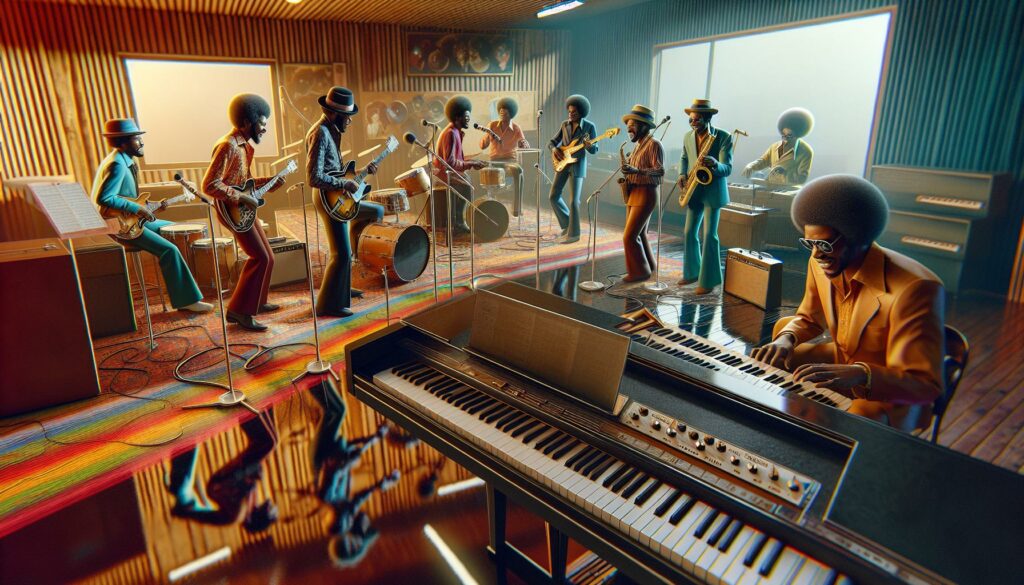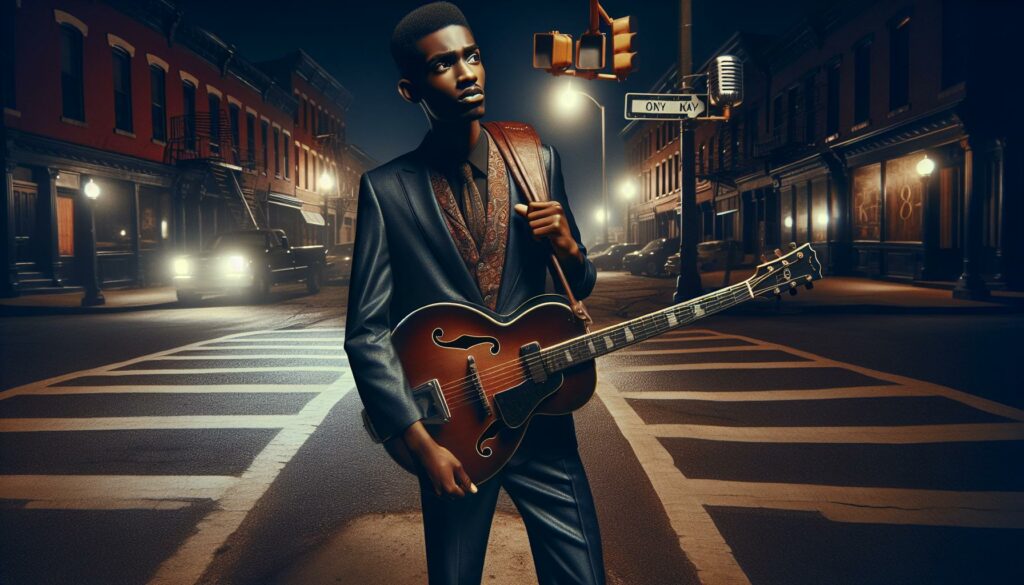I’ve always been captivated by the raw emotion and powerful rhythms of 1970s soul music. This golden era gave birth to some of the most influential artists and timeless classics that still move us today. From the smooth vocals of Al Green to the funk-infused sounds of Curtis Mayfield, soul music defined an entire generation.
The 1970s marked a transformative period when soul music evolved beyond its R&B roots to embrace new elements of funk, disco, and psychedelic sounds. I’m constantly amazed by how artists like Marvin Gaye and Stevie Wonder pushed creative boundaries while addressing social issues through their music. This decade produced countless hits that continue to influence modern artists and resonate with music lovers worldwide. Let’s dive into the rich history of this remarkable musical movement that changed American culture forever.
Key Takeaways
- Soul music reached its creative peak in the 1970s, evolving beyond R&B to incorporate funk, disco, and psychedelic elements while addressing social issues.
- Motown Records and Philadelphia International Records dominated the era, with innovative production techniques and signature sounds that included sophisticated arrangements and layered instrumentation.
- Legendary artists like James Brown, Marvin Gaye, and Stevie Wonder revolutionized the genre through groundbreaking albums and socially conscious lyrics.
- The distinctive sound of 1970s soul was characterized by specific instruments (Fender Rhodes, Hammond B3, horns) and recording techniques (plate reverb, tape compression) at iconic studios.
- Soul music’s influence extended beyond music to shape fashion trends, dance movements, and visual aesthetics of the decade.
- The genre’s legacy continues to impact modern music through sampling, production techniques, vocal styling, and social consciousness in contemporary R&B, hip-hop, and pop.
1970s Soul Music
Soul music reached its creative peak in the 1970s, expanding beyond its R&B roots to incorporate sophisticated arrangements, social consciousness, and diverse musical influences.
Motown’s Golden Era
Motown Records dominated the early 1970s with innovative productions featuring layered instrumentation and polished vocal harmonies. Artists like The Jackson 5, Diana Ross, and Marvin Gaye transformed the label’s signature sound by incorporating funk elements and complex orchestrations. The legendary Studio A at Hitsville USA produced 10 number-one hits between 1970-1973, including “”What’s Going On”” and “”I Want You Back.”” The label’s sonic blueprint expanded through technological advances like the 24-track recording system, enabling producers to create richer, more textured arrangements.
Philadelphia Soul Movement
The Philadelphia International Records label established a distinctive soul sound characterized by lush orchestration, driving bass lines, and sophisticated vocal arrangements. Kenny Gamble and Leon Huff’s production team created hits for artists like The O’Jays, Harold Melvin & The Blue Notes, and MFSB. Their signature elements included:
- Soaring string sections recorded at Sigma Sound Studios
- Syncopated horn arrangements by Bobby Martin
- Latin-influenced percussion patterns
- Four-on-the-floor drum beats
- Socially conscious lyrics addressing urban issues
| Year | Achievement | Details |
|---|---|---|
| 1972 | Gold Records | 5 albums certified gold |
| 1973 | Billboard #1s | 3 consecutive chart-toppers |
| 1974 | Grammy Awards | 2 wins for production |
| 1975 | Sales Revenue | $25 million in revenue |
Influential Soul Artists of the Decade
The 1970s marked a transformative period for soul music, led by pioneering artists who redefined the genre through innovation and artistic excellence. These influential figures shaped the sound and message of soul music while achieving unprecedented commercial success.
James Brown and Funk Evolution
James Brown revolutionized soul music by introducing intense rhythmic patterns and emphasizing the “”one”” beat, creating the foundation of funk. His landmark albums “”Get Up (I Feel Like Being a) Sex Machine”” (1970) and “”The Payback”” (1973) showcased his signature style with dynamic horn sections and syncopated guitar riffs. The J.B.’s, his backing band, featured musical innovators like Bootsy Collins and Fred Wesley who contributed to classics such as “”Super Bad”” and “”Soul Power.”” Brown’s innovations influenced:
- Extended instrumental breaks featuring intricate rhythmic interplay
- Call-and-response patterns between vocals and instruments
- Polyrhythmic percussion arrangements with emphasis on the downbeat
- Integration of jazz elements into soul compositions
- Urban poverty depicted in “”Inner City Blues (Make Me Wanna Holler)””
- Environmental concerns explored in “”Mercy Mercy Me (The Ecology)””
- Anti-war sentiments expressed in the title track “”What’s Going On””
- Personal relationships examined in “”Let’s Get It On”” (1973)
| Album | Year | Peak Billboard Position | Weeks on Chart |
|---|---|---|---|
| What’s Going On | 1971 | #6 | 58 |
| Let’s Get It On | 1973 | #2 | 61 |
| I Want You | 1976 | #4 | 40 |
The Sound of 1970s Soul
The distinct sound of 1970s soul emerged from innovative recording techniques combined with signature instrumental arrangements. The genre’s sonic identity centered on warm analog recordings enriched by sophisticated orchestration.
Signature Instruments and Production
Soul music’s characteristic sound relied on essential instruments that defined the era’s productions:
- Fender Rhodes electric piano created warm, bell-like tones in tracks like “”Let’s Stay Together””
- Hammond B3 organ added rich layers through Leslie speakers on classics like “”What’s Going On””
- Funk Brothers’ precise bass lines drove Motown hits with Fender Precision Bass guitars
- Memphis Horns section featuring trumpets, saxophones and trombones enhanced Stax recordings
- Congas and timbales introduced Latin percussion elements in Philadelphia International tracks
- Moog synthesizers appeared on pioneering albums like Stevie Wonder’s “”Innervisions””
Production techniques that shaped the 1970s soul sound included:
| Technique | Purpose | Notable Example |
|---|---|---|
| Plate reverb | Created spacious vocals | “”Midnight Train to Georgia”” |
| Tape compression | Added warmth to rhythm sections | “”Papa Was a Rollin’ Stone”” |
| Multi-tracking | Enabled layered arrangements | “”I Want You Back”” |
| Live room recording | Captured band dynamics | “”Theme from Shaft”” |
Notable Recording Studios
Key recording facilities shaped the distinctive sound of 1970s soul music:
- Sigma Sound Studios in Philadelphia housed state-of-the-art 24-track recording equipment
- Muscle Shoals Sound Studio in Alabama featured natural room acoustics for authentic sounds
- United Sound Systems in Detroit recorded numerous Motown classics before 1972
- Criteria Studios in Miami provided cutting-edge recording technology for soul artists
- American Sound Studio in Memphis captured raw emotional performances
- RCA Studio B in Nashville contributed to countrypolitan soul crossover recordings
| Studio Equipment | Impact | Iconic Recording |
|---|---|---|
| API Console | Enhanced clarity | “”Love Train”” |
| 3M Tape Machines | Improved fidelity | “”Superstition”” |
| Neumann U47 Mics | Captured vocal warmth | “”Me and Mrs. Jones”” |
| EMT Echo Plates | Created spatial depth | “”Could It Be I’m Falling in Love”” |
Fashion and Cultural Impact
The 1970s soul scene created distinctive fashion trends that reflected the era’s emphasis on self-expression and cultural pride. Soul music’s influence extended beyond sound to shape clothing styles, dance movements and visual aesthetics that defined the decade.
Soul Fashion Trends
Soul artists popularized bold fashion statements that combined luxury with urban sensibility. Men’s fashion featured platform shoes, bell-bottom pants, wide-collar shirts in vibrant patterns and tailored suits with dramatic lapels from designers like Nino Cerruti. Women embraced flowing maxi dresses, jumpsuits with elaborate embellishments, hot pants paired with knee-high boots and afro hairstyles adorned with headbands. Iconic looks included Isaac Hayes’s gold chains, The Supremes’s sequined gowns and James Brown’s cape-and-jumpsuit combinations that influenced mainstream fashion trends.
Dance and Performance Styles
Soul performances introduced signature dance moves that became cultural phenomena. The Soul Train Line, featured on Don Cornelius’s groundbreaking TV show, showcased individual expression through synchronized partner dancing and improvisational solo routines. Artists developed distinct stage personalities through choreographed moves – The Temptations’s precise steps, James Brown’s dynamic splits and spins, Michael Jackson’s robot dance. Popular social dances like the Robot, the Bump and the Hustle emerged from soul clubs and gained widespread adoption across America’s dance floors. These movements emphasized rhythm, attitude and personal style while fostering community through shared cultural expression.
Soul Music’s Legacy and Influence
Soul music’s influence spans multiple generations through its integration into contemporary genres like hip-hop, R&B and pop music. Modern artists sample iconic soul tracks, incorporating the genre’s musical elements into their work. Drake’s “”Nice For What”” samples Lauryn Hill’s “”Ex-Factor,”” which draws from Wu-Tang Clan’s “”Can It Be All So Simple,”” originally sampling The Stylistics’ “”Could It Be I’m Falling in Love.””
The production techniques pioneered in 1970s soul transformed modern recording practices. Notable innovations include:
- Layered vocal harmonies in Beyoncé’s arrangements
- Extended instrumental breaks in Mark Ronson’s productions
- String orchestrations in Adele’s ballads
- Horn section arrangements in Bruno Mars’ recordings
Soul music’s impact on vocal performance remains evident in contemporary artists:
- Melismatic runs popularized by Al Green
- Call-and-response patterns from The O’Jays
- Gospel-influenced belting from Aretha Franklin
- Falsetto techniques from Curtis Mayfield
The genre’s social consciousness influenced modern protest music through:
| Impact Area | Example Artists | Notable Songs |
|---|---|---|
| Racial Justice | John Legend | “”Glory”” (2014) |
| Economic Inequality | Alicia Keys | “”Empire State of Mind”” (2009) |
| Urban Issues | Anderson .Paak | “”Lockdown”” (2020) |
| Social Change | H.E.R. | “”I Can’t Breathe”” (2020) |
Soul music’s recording innovations continue shaping modern production through:
- Analog warmth from tape compression
- Live room acoustics capture
- Dynamic microphone placement
- Vintage equipment emulation
The Philadelphia Soul sound influences contemporary arranging through:
- Orchestral string sections
- Syncopated horn arrangements
- Four-on-the-floor drum patterns
- Walking bass lines
These elements appear in modern hits like “”Uptown Funk”” by Mark Ronson and “”Love On Top”” by Beyoncé, demonstrating soul music’s enduring impact on popular music production and arrangement.
The 1970s soul music era stands as a testament to the power of artistic innovation and social consciousness. I’ve witnessed how this golden age of soul continues to resonate through modern music production stylistic choices and sampled tracks.
From the groundbreaking studio techniques to the unforgettable melodies these incredible artists delivered the 1970s created a musical blueprint that’s still followed today. The rich legacy of artists like Marvin Gaye Al Green and Curtis Mayfield proves that great music transcends time.
When I listen to the soulful sounds of the 1970s I’m reminded that this wasn’t just music – it was a cultural revolution that changed how we think about rhythm harmony and social commentary in popular music.



